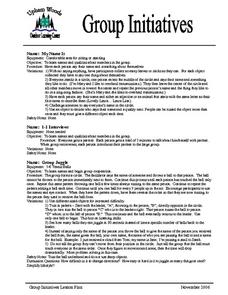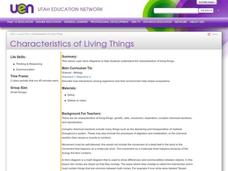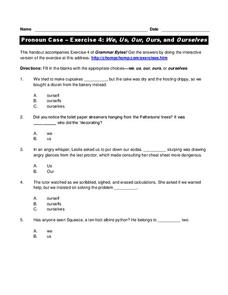Curated OER
Meiosiss Revisited
Seventh graders are engaged in a lesson that covers the concept of meiosis with the intention of covered sexual reproduction. They cover the concept of genetic traits and how they are transmitted over generations with or without...
Curated OER
The Beagle Brigade
Students brainstorm how to handle conflict scenario. In this character education lesson, students read a story and respond as to how the characters should handle the conflict. Students examines feelings of characters and...
Curated OER
What Is A Fossil?
In this fossils worksheet, learners read 13 clues pertaining to fossils. Students fit their answers in a crossword puzzle. There is no word bank.
Curated OER
Egg Toss
This cross curricular lesson involves eggs. Students read about eggs. A counting game involving an egg carton and ping pong balls (eggs) is played as students toss balls into numbered egg carton cups and adding their score. Students...
Curated OER
Group Initiatives
Students explore the names and qualities about members in the group. They each say their name and something about themselves. Students gather around in a circle. They listen to the teacher as he or she says the name of someone and throws...
Curated OER
Biotechnology
In this biology worksheet, students complete a crossword puzzle with 23 questions on biotechnology. They identify the benefits and ethical issues about biotechnology.
Curated OER
Knowledge Quiz: Bacteria
In this bacteria quiz worksheet, students complete a set of 10 multiple choice questions covering a variety of concepts related to bacteria. A reference web site is included for additional resources.
Curated OER
Science Quiz B-Grade 5
In this grade 5 science quiz learning exercise, 5th graders complete a 15 question multiple choice quiz covering a variety of grade 5 concepts.
Curated OER
DNA: The Search for the Genetic Material
Students study the history of DNA and how to extract it. In this genetic activity students complete a DNA experiment using bacteria.
Curated OER
Shells
Sixth graders label diagrams of the 6 different classes of mollusks and explain the meaning of the labeled terms. They identify 8 common New Haven shells. They organize their own shell collection during this series of lessons.
Curated OER
Molecular Evidence for Evolutionary Relationships
Students compare the amino acid sequences in cytochrome-c for a variety of organisms and use this information to infer evolutionary relationships. Students investigate the role of homeobox genes and what this indicates about the...
Curated OER
Discovering Owls
Pupils are introduced to different types of owls and owl pellets. They list several adaptations that benefit the owls. Students identify the various species of owl that live in Wisconsin. Pupils discuss owl pellets and identify the...
Curated OER
Origins Video Questions
In this biology learning exercise, students complete 19 short answer questions about biodiversity and information obtained during a class video.
Curated OER
Woodland Math Facts
For this Woodland math facts worksheet, students study and examine woodland weights of trees and shrubs, explore invertebrates and draw a bar chart to chart their findings.
Curated OER
Characteristics of Living Things
Students examine the characteristics of living things. They list the differences between living and non-living things, explore areas around the school, and create a Venn diagram for items found in the school areas.
Curated OER
Undercover in the Secret State
Learners examine the current conditions in North Korea. They view and analyze a CNN documentary, research a dissident, answer and discuss questions about the documentary on conditions in North Korea, and identify the technology used by...
Curated OER
Fossil Impressions of Ancient Life
Students make a mold using Plaster of Paris and then make a cast using that same mold. They pick a fossil and describe how it looks. They write a fictionalized story about its life, or burial. (
Curated OER
Living vs. Non-Living Things
Fourth graders describe the characteristics that determine if something is living, dead, or non-living. They determine the difference between living and non-living things. Students determine if an object is living or non-living and...
Curated OER
CLOTHESLINE SLEUTH
Pupils will trace origins of various forms of clothing to their agricultural sources.String a cotton cord across the top of a blackboard to resemble a clothesline. 2. Bring a variety of clothing articles to class made from a variety of...
Curated OER
COMMON KINDS OF INSECTS
Students will recognize and name three common insects.1. Share background information with students. 2. Provide students with the "bug body" puzzle pages, and have them cut the puzzles out.1. Share background information with students....
Curated OER
Ecology 8 Land Biomes
Students identify and describe the main features of one land biome. After researching what a biome is, they give various examples of biomes around the world and in their backyards.
Curated OER
Outdoor Survival
Young scholars are introduced to basic outdoor survival concepts. They identify the seven basic needs for survival. Students describe the symptoms and treatment for frostbite and hypothermia. They compare and contrast the value of...
Curated OER
Protists
For this protists worksheet, students will review the different types of protists and the different stages of the protist life cycle. This worksheet has 10 matching questions.
Curated OER
Pronoun Case - Exercise 4: We, Us, Our, Ours, and Ourselves
In this interactive online personal pronouns practice worksheet, students respond to 20 multiple choice questions using the appropriate pronoun case.

























